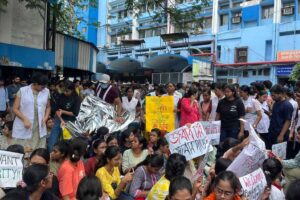“The R.G. Kar case has created turmoil across the entire state and country. The loud of the protests has even reached abroad. Doctors have also joined the protests, demanding ‘justice for the victim.’ Every day, thousands of people are taking on the streets with this demand. Discussions are going on social media, with both true and false information being spread. Overall, the situation remains tense.”

However, this is not the first time that service workers have been attacked, tortured, or harassed. It has happened before. People have taken to the streets before. The cry for ‘justice’ has been raised before. But has the situation really changed much? This is the question many are asking?

If you look into the history of violence against service workers in India, it will undoubtedly include the horrific abuse that occurred 50 years ago against Aruna Shanbaug.
To prevent Aruna from escaping, a dog leash was wrapped around her neck. When Sohanlal attempted to rape her, he noticed that she was menstruating.

After the assault, Aruna lay in that condition in the hospital’s basement for 11 hours. By the time doctors found her the next morning, the oxygen supply to her brain and spinal cord had been cut off. From that point on, Aruna’s brain was half damaged, and she lost both her vision and speech. Gradually, she slipped into a coma.

In protest against the atrocities committed against Aruna, nurses in Mumbai took to the streets. The city erupted in anger, much like Kolkata did during the R.G. Kar incident. Mumbai’s nurses called for a strike, demanding justice for Aruna and security for nurses.

Although doctors and nurses at the hospital provided special care to Aruna for four decades, feeding her through a tube and ensuring regular cleanliness, the doctor who was supposed to marry her had long since moved away from Aruna’s side.
Aruna endured suffering for 42 continuous years, lying on that hospital bed like an immoveable object. In the final years, the pain was no longer visible.

In 2009, journalist and activist Pinki Virani filed a petition the Supreme Court indirectly for Aruna’s mercy killing. Her request was to end the life-sustaining measures keeping Aruna artificially alive, thereby accelerating her death.

However, the hospital’s doctors and nurses strongly opposed Pinki’s request. In response, the Supreme Court rejected Pinki’s petition in 2011. The court stated that for what Pinki was asking, the hospital staff needed to agree, and it would require the approval of the Mumbai High Court.

This was the first time the Supreme Court acknowledged that voluntary mercy killing should be legally recognized. Several years later, the Supreme Court ruled that those suffering severe pain on their deathbeds would be allowed to seek voluntary mercy killing.
Please like and subscribe my channel to stay updated on current affairs and news bulletin